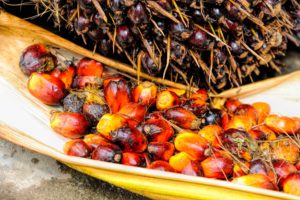 Palm oil has a reputation as a “bad” product, but do we really know why this is, and where it’s used? And more importantly, can we do something about it?
Palm oil has a reputation as a “bad” product, but do we really know why this is, and where it’s used? And more importantly, can we do something about it?
Palm oil is a vegetable oil derived from the fruit of oil palms. Over three-quarters of its production occurs in Indonesia and Malaysia. Palm oil is used in a wide variety of products, from food (margarine, biscuits, bread, etc.), to everyday products (detergents, candles, shampoos, etc.), to fuel or even bioenergy. According to Oil World 2013, the annual production of palm oil in 2012 was close to 60 million tons.
Palm oil is generally considered a “bad” product because it does not become easily rancid, its shelf life is high compared to other vegetable oils. Unlike other vegetable oils, palm oil is also naturally semi-solid, making it suitable for solid applications. It is also the most productive vegetable oil with relatively modest inputs. Wherever oil palms are grown, palm oil plays a big part of the economy, providing livelihoods for local communities and helping lift people out of poverty. However, due to its high yield capability, forests are being destroyed – usually burned down – to increase plantation area for oil palms. This deforestation has a big impact on the ecosystem living in that area, causing some species such as rhinos, elephants, orangutans, tigers, etc., to become endangered or even extinct. The destruction of the forest by fire also greatly contributes to climate change, due to the release of methane and other greenhouse gases into the atmosphere.
In 2004, the RSPO (Roundtable on Sustainable Palm Oil), a non-profit organization, was created to address these issues. In 2008, RSPO developed a set of environmental and social criteria to produce sustainable palm oil. CSPO (Certified Sustainable Palm Oil) means that the oil palm plantation has been established on land that did not contain significant biodiversity, wildlife habitat or other environmental values, and meets the highest environmental, social and economic standards as set out by the RSPO, such as transparency, regulatory compliance, long-term economic and financial viability, best growers and millers’ practices, fair working conditions, etc. According to the WWF, in 2013, fifteen percent of palm oil production worldwide was certified as sustainable (CSPO), a number that continues to grow every year. However, with a higher price point than non-certified palm oil, the market tends to favor the use of non-certified palm oil over CSPO.
RSPO is now also focusing on transparency and providing any concerned party with access to the data collected, after critics raised concerns about the inadequate assessments and audits required to certify a palm oil plantation and production as sustainable.
In addition, the WWF is supporting the CSPO project to increase the use of sustainability practices aimed at reducing the devastating environmental consequences of unsustainable palm oil.
Golden Agri-Resources (the second-largest palm oil plantation company) and many others are aiming to achieve fully traceable and transparent supply chains by 2020. Large consumer groups as well as traders are also taking part in the sustainable palm oil market by asking their suppliers to follow the RSPO sustainable standard practices and release a detailed sustainable implementation plan. There is a clear need for suppliers and retailers to accelerate efforts to develop, down to the farm, a fully transparent palm oil sector to thoroughly assess its impact.
This article originally appeared in Asia Food Journal on August 3rd 2016
To learn more about palm oil’s links to deforestation, read our blog “Improving the status quo: achieving deforestation-free supply chains”
UPDATE: Amnesty International’s latest report reveals the world’s most popular household companies are selling food, cosmetics and other everyday staples containing palm oil tainted by appalling human rights abuses—despite claims of sustainability.










